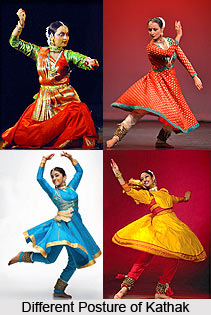 Style of Kathak has a definite grace of its own. Torso movements form a major part of this dance style however it is not performed a s a single unit as in Bharatnatyam or divided into two units, the chest and the waist, as in Manipuri. In Kathak only the shoulder line changes its position which apparently is a manipulation of the upper torso. This gives the style of Kathak its peculiar flexibility and some of its torso postures which are typical to this dance.
Style of Kathak has a definite grace of its own. Torso movements form a major part of this dance style however it is not performed a s a single unit as in Bharatnatyam or divided into two units, the chest and the waist, as in Manipuri. In Kathak only the shoulder line changes its position which apparently is a manipulation of the upper torso. This gives the style of Kathak its peculiar flexibility and some of its torso postures which are typical to this dance.
The shoulder line and its shift are execution of the movements is known as the Kasak masak. The arms have a definite movement but they do not make any single geometrical pattern. The basic posture is when the dancer holds a variation of the hamsasya hasta above the head and the second arm is extended sideways or in front which is slightly curved. In this the mukuta of Lord Krishna is represented by the right hand and the holding of Radha on his left side by the other. There are many Hastas used in this dance style. The mushti, the sikhara, the hamsasya, the chandrakala, and the alapadma are common ones used.
Style of Kathak is characterised by features like its jumps and spins. These are the utplavanas and bhramaris in the Natyashastra. Both feet are lifted together in a simple jump is characteristic of Kathak only. In Kathak there is only a release from gravity and there is no attempt on the part of the dancer to cover space forward or backward through the process of the jump. In the bhramaris, the Kathak dancer maintains the axis of the body by using one foot as a centre and the other foot to make a circle. The pirouettes are usually the final sequences of a dance. They are grouped together in a series of three.
Limited face movements are there though great emphasis is placed on the movements of the eyebrows. The use of the eyebrows for the lasyanga is a typical characteristic of this dance style. As far as neck movements are concerned Kathak has similarities with Bharatnatyam. The horizontal, side-to-side movement of the neck is used most frequently in Kathak and Bharatnatyam.



















